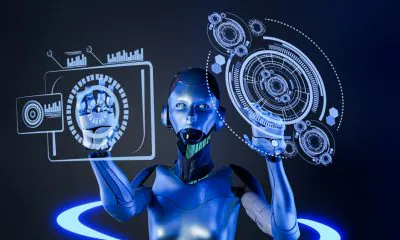Robotics
Researchers Have Developed Insect-Like Robots Based on Cockroaches

Researchers at the University of California, Berkely have created a tiny, insect-like robot based on a cockroach. It can move across a surface just a fast, and it is just as hardy as a cockroach. It is extremely difficult to break which is uncommon for robots that size. The study has just been published in the journal Science Robotics on July 31.
Liwei Lin, a professor of mechanical engineering at UC Berkeley and senior author of a new study, described the robot.
“Most of the robots at this particular small scale are very fragile. If you step on them, you pretty much destroy the robot,” she said. “We found that if we put weight on our robot, it still more or less functions.”
The new insect-like robot seems very simple when looking at it, but that’s not the case at all. As mentioned earlier, it can move across the ground similarly to a cockroach. It is capable of moving at a speed of 20 body lengths per second. That means this tiny robot can travel far distances in short amounts of time. The speed that the robot can travel is the fastest among current insect-scale robots that have been developed.
Aside from being fast, the small insect-like robot can also carry weight. While it is a small amount, something the size of a peanut, it still is an impressive development and can be built upon.
The most impressive ability of this technology is the amount of weight it can withstand. The insect-like robot weighs less than one tenth of a gram, but it can withstand up to 60kg. That is the weight of an average human, and it is 1 million times more than the robot.
“People may have experience that, if you step on the cockroach, you may have to grind it up a little bit, otherwise the cockroach may still survive and run away,” Lin said. “Somebody stepping on our robot is applying an extraordinarily large weight, but [the robot] still works, it still functions. So, in that particular sense, it’s very similar to a cockroach.”
The small insect-like AI robots can be used for many different things including search and rescue missions. They are tiny enough to be able to fit into places humans can’t or places that are too dangerous for humans to go.
Yichuan Wu, first author of the paper, spoke about it. He worked on this project as a graduate student in mechanical engineering at UC Berkeley through the Tsinghua-Berkeley Shenzhen Institute partnership. He is currently an assistant professor at the University of Electronic Science and Technology of China.
“For example, if an earthquake happens, it’s very hard for the big machines or the big dogs, to find life underneath debris, so that’s why we need a small-sized robot that is agile and robust,” he said.
The insect-like robot is the size of a large postage stamp, and it is made of a thin sheet of piezoelectric material called polyvinylidene fluoride (PVDF). These are unique materials, and they expand and contract when an electric voltage is applied to them. The PVDF of the robot is covered with a layer of an elastic polymer. This allows the entire sheet on the robot to be flexible and bend instead of expanding and contracting. A front leg was added to the insect robot which allows it to leap and propel forward as the material bends and straightens under an electric field.
This technology is still being developed, and this insect-like robot will keep getting more advanced. It currently uses a thin wire that is attached in order to carry an electric voltage responsible for the oscillations. The next step for the technology is to add a battery which will allow it to move more freely. The researchers also want to improve the design as well as add gas sensors. The idea is that the insect-like robot will be able to move independently and around obstacles.
This new development in technology follows a pattern in the AI and insect-robot field. Swarm Intelligence and Ant Robots were recent developments that use similar technology. It will be exciting to see where this technology will go, and it can be useful in many different areas of our society.














